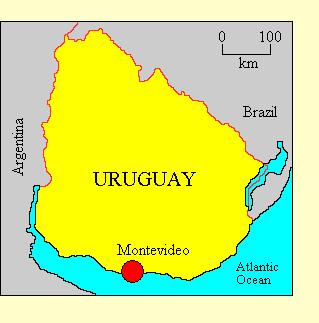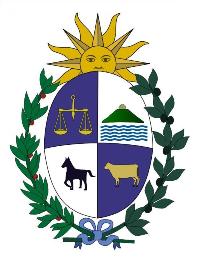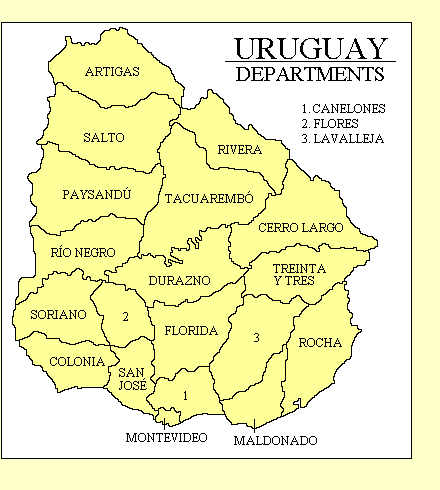

EASTERN REPUBLIC
OF URUGUAY
• Official name: Republica Oriental del Uruguay (Eastern Republic of Uruguay)
(Uruguay is called the "Eastern" republic because it lies on the eastern side of the
River Plate estuary, while Argentina lies on the western side.)
• Location: South America
• International organisations: Organisation of American States, United Nations, World Trade
Organisation
• Borders: Argentina, Brazil
• Coastline: Atlantic Ocean
• Land area: 176,220 Km2
• Population: 3,400,000
• Annual GDP (PPP) per capita: US$12,700 (2009 CIA estimate). World ranking: 69
• Ethnicity: Nearly the whole population is of European (mostly Spanish) descent.
There are small mestizo (mixed European and Amerindian) and African-descended
minorities.

• Languages: Spanish is the official language and is universally used.
• Religion: About 70% of the population are nominal Christians, mostly Catholic, but
Uruguay is the most secularised country in Latin America.
• Form of government: Presidential democratic republic. Uruguay is divided into
19 Departments.
• Capital: Montevideo
• Constitution: The
Constitution of the Republic of Uruguay came into effect on 27 November 1966.
It was suspended from 1973 to 1989, and substantially amended in 1997.
• Head of state: The President, elected by direct universal suffrage for a
five-year term.
• Head of government: The President, who appoints all ministers.
• Legislature: Uruguay has a bicameral legislature, the
General Assembly (Asamblea General).
The Chamber of Deputies (Camara de Diputados) has 99 members, elected for five-year
terms by proportional representation.
The Chamber of Senators (Camara de Senadores) has 30 members, elected for five-year
terms by proportional representation, plus the Vice-President.
• Electoral authority: The Electoral
Council administers national elections.
• Freedom House rating:
Political Rights 1, Civil Liberties 1
Political history
Uruguay was brought under nominal Portuguese control in the early 17th century, but
was occupied by the Spanish in 1726 and became part of the viceroyalty of La Plata, in effect
as a colony of Buenos Aires. When the authorities in Buenos Aires declared their
autonomy in 1808, Uruguay at first remained loyal to Spain, but became independent
in 1810. It was fought over by Argentina and Brazil until 1828, when after British
mediation it became the independent republic of Uruguay.

Through most of the 19th century Uruguay was torn by bitter rivalry between the
liberal Red Party and the conservative White Party (the Colorados and the Blancos), which descended at times into civil war and
led to intevention by Argentina and Brazil. In 1872 the two parties agreed to a peace
treaty, and Uruguay enjoyed stability and progress under the Colorado leader Jose
Batlle y Ordonez.
After Batlle's death in 1929 the Blancos staged a coup and Uruguay was a
dictatorship until 1938, when the Colorados regained power and restored constitutional
government. The Blancos regained office in 1958, and political instability increased
through the 1960s, aggravated by economic difficulties. The emergence of the communist
guerilla movement, the Tupamaros, led to the imposition of martial law by President
Juan Maria Bordaberry in 1972.
In 1976 the army took power and retained it until 1985,
when democractic government was again restored. Since then Uruguay has become of the most
stable and liberal states in Latin America. Politics was dominated for many decades by the liberal
Colorados and the conservative Blancos (officially
theNational Party (PN). But in
2005 the left-wing
Broad Front (FA) coalition broke the two-party
system when its candidate
Tabare Vazquez was elected
President, and the Front won a majority of seats in the Congress. The Broad Front includes the
Socialist Party of Uruguay (PS), the centrist
Uruguay Assembly, the
Christian-Democratic Party, and
other leftist parties including the Communist Party of Uruguay.
At the 2009 elections, the Broad Front candidate, the veteran leftist
Jose Mujica was elected president. He took
office in March 2010, at the age of 74.
Updated March 2010
|

